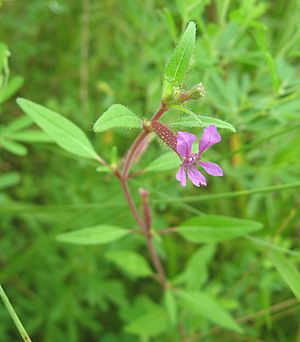Blue waxweed facts for kids
Quick facts for kids Blue waxweed |
|
|---|---|
 |
|
| Scientific classification | |
| Genus: |
Cuphea
|
| Species: |
viscosissima
|
| Synonyms | |
|
|
Cuphea viscosissima, often called blue waxweed or clammy cuphea, is a special kind of plant. It belongs to the loosestrife family. This plant is known for its sticky stems. It grows naturally in the eastern United States.
You can often find blue waxweed in open, rocky areas. These places usually have soil rich in calcium. It is the most common type of Cuphea plant found in the U.S.
Contents
What is Blue Waxweed?
Blue waxweed is an herbaceous plant. This means it has soft, green stems instead of woody ones like trees or shrubs. It grows new stems and leaves each year.
This plant gets its name "blue waxweed" from its pretty flowers. It also gets "clammy cuphea" because its stems feel sticky. This stickiness is a unique feature of the plant.
Its Sticky Stems
The stems of Cuphea viscosissima are very sticky. This stickiness comes from tiny hairs on the stem. These hairs produce a special, sticky substance.
This sticky coating might help the plant in a few ways. It could protect it from insects. It might also help catch pollen or seeds.
Where Does Blue Waxweed Grow?
Blue waxweed is native to the eastern parts of the United States. This means it naturally grows there. It thrives in specific environments.
You can often find it in places with lots of sunlight. It likes open areas, such as fields or rocky slopes. The soil in these areas often contains a lot of calcium.
Preferred Habitats
This plant prefers rocky areas. It also likes soil that is calcareous. Calcareous soil is rich in calcium carbonate. This is the same material found in limestone.
These conditions help the plant grow strong. They provide the right nutrients for blue waxweed. It is the most widespread Cuphea species in the U.S.
Flowers and Appearance
Blue waxweed produces beautiful flowers. These flowers are usually purple-red in color. They add a splash of color to the landscape.
The plant typically blooms in late summer. This is when its flowers are most visible. They are a sign of the changing seasons.
How to Tell it Apart
Cuphea viscosissima looks a lot like another plant called Cuphea lanceolata. That plant grows in Mexico. However, there is a simple way to tell them apart.
Blue waxweed has smaller flowers. The flowers of Cuphea lanceolata are larger. This difference helps scientists identify each species.
See also
 In Spanish: Cuphea viscosissima para niños
In Spanish: Cuphea viscosissima para niños

